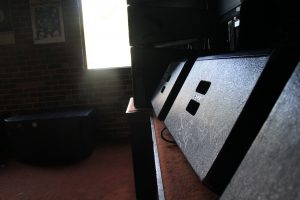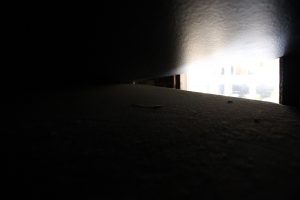Moving forward from Assignment 3, I was still intrigued with the notion of emptiness that we emphasised with that assignment. After a discussion with Georgia and Daniel, we defined our goals heading into the next assignment as follows:
- Emphasise community
- Expand scope from Assignment 3
- Explore presence
- Deviate from Assignment 3
From here, I felt that the best way to explore community and presence would be to immerse myself directly within it. By spending time at the Tote and allowing myself to be involved in the culture, I felt that the process would be organic and meaningfully connected to the function of the venue. At this stage I still had a vague conception of what I wanted to actually produce for Assignment 4, until Robbie took us to the local RMIT gallery space to experience the work of Nathan Gray, which by chance also had the visual art of Daniel Crooks on display. The amorphous, flowing nature of Crooks’ work had a big impact at the time and provided an aesthetic inspiration that set me on the trajectory for the creation of my own piece.
My process became fairly regular attendance at the Tote when gigs were happening to record moments specifically shared between the audience and the artists. I chose to isolate my technical approach to purely audio in an attempt to engage as wholly as I could with the way the venue sounds. In a way, the process called back to the beginnings on the studio, and I felt as though I was using the zoom recorder to expand my awareness of the moment, the reciprocal energy that flows between the audience and the artist and how this energy feeds into the experience of being at the Tote. What I found is that the totality of the experience is what distinguishes it from any other, that is, the presence of people interacting with the music and talking to each other, creating the atmosphere between songs, all of this amounts to the distinct nature of the various subcultures that pass through and flourish at the Tote. Philip Auslander describes this experience in Liveness: Performance in a Mediatized Culture, where “the value of live performance derives from its existence only in the moment, and its putative ability to create community (if not communion)”. The audience’s engagement with the transparency of an artistic performance amounts to a sort of spiritual experience of catharsis, celebration and an interest in cultivating a particular cultural movement.
To further inform my investigations I was inspired by the central ideas at the core of a collation of RMIT Masters of Interior Design research projects entitled INTERsection, proposed by Suzie Attiwell in her essay of the same name. The use of the word ‘intersection’ in this instance is the marriage of ‘interior’ and ‘section’, which she used to frame the function of the collation itself, creating “an assemblage of individual and intersecting projects”, and that simply by engaging with these works within the collation is “to be among projects”, that is, intersecting with them. I feel that this idea can be applied to the way in which the artist and audience intersect with one another at the Tote, creating the cultural force that passes through the Tote.
With all of this in mind, I chose to centralise the community in my piece as the vital source of energy that sustains the cultural momentum that can be found at the venue. Surrounding this, passages of musical performances seep in to the periphery in the same way that one might find music beckoning them from various passages of the venue itself.
See below a link to the finished piece:











